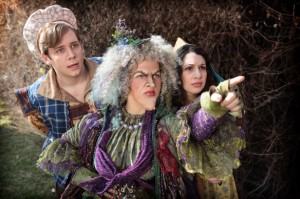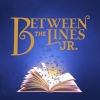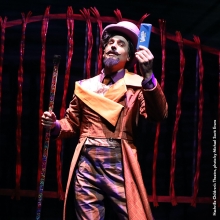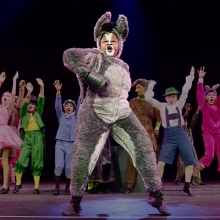Filichia Features: Into Some New Woods
Filichia Features: Into Some New Woods
Chris Blem, Victoria Cook and Michelle Rombola in CCM's Mainstage Production of 'Into the Woods.' Photography by Mark Lyons.
Too bad everyone couldn’t see Aubrey Berg’s recent Into The Woods at the University of Cincinnati-Conservatory of Music. The CCM production would have offered some valuable suggestions and alternatives to those thinking of producing Stephen Sondheim and James Lapine’s fractured fairy tale.
Into The Woods consists of a mainly funny first act and a mostly serious second act. And yet, since its Broadway premiere in 1987, much of the Act One fun has been lessened because so much of it takes place during dusky late afternoon and dark night in a tree-dominated forest. Comedy, however, plays best when it’s brightly lit.
Berg first dispensed with a realistic forest, and requested that set designers Ryan Howell and Brian J. Ruggaber build a stage that would resemble a Shakespearean one. “What I noticed while reading Into the Woods,” he said, “is that the expression ‘Another part of the forest’ crops up now and then. That’s a line that’s often found in Shakespeare, so I thought, well, why not play it on a stage that resembles the current Globe Theatre in London?”
Thus, the three-sided structure had a balcony dead center – all the better for Jack (of Beanstalk fame) to sing “Giants in the Sky.” The height suggested that he was just coming down from his journey into space. High above stage right was a small window and Romeo-and-Juliettish balcony that served as Rapunzel’s tower. On the same level at stage left was another window where many of the other fairy tale characters made brief appearances.
The absence of trees helped to alleviate the darkness, but lighting designer Tim Schmall contributed even more by making the action seem to take place under a full moon. The added wattage allowed audiences to better see and enjoy Little Red Ridinghood’s contretemps with Wolf, Cinderella’s landing while escaping from the Prince and the painful shoe-fittings on stepsisters Florinda and Lucinda’s too-large feet.
And given that a full moon is said to bring out emotions in people that they don't usually display, the bright lighting helped to explain the atypical behavior between the (nameless) Baker and his Wife. Audiences could better see their expressions while they endeavored to break The Witch’s curse that would finally give them a child. Baker had a sheepish look on his face when he stole and returned to Little Red Ridinghood her “cape as red as blood.” Similarly, his Wife looked guilty when she snatched away “the slipper as pure as gold” from Cinderella, panicked when “the cow as white as milk” ran away from her, and astonished when she discovered an abundance of “hair as yellow as corn” in the long tresses that cascaded from Rapunzel’s tower.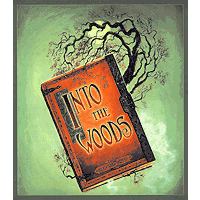
For the scene in which Little Red Ridinghood goes into Grandmother’s bedroom, Berg put Wolf in a bed that was standing up vertically. (Think of the one in which Hairspray's Tracy Turnblad was first seen.) Thus, Wolf was sandwiched between two pieces of wood – the outer one representing “the bedspread” and the one behind him serving as “the mattress.” Once Wolf attacked the lass, the space in between the boards served as a Punch and Judy stage. Also in there was Granny, as we saw after she and Little Red had rolled out of the “bedspread’s” low trap door and almost into the orchestra pit.
For centuries, children have listened to the tale of Little Red Ridinghood and Wolf, and have become accustomed to her three observations about her “grandmother’s” eyes, ears, hands and teeth – each of which caused Wolf to respond. Here, after the girl brought up her fourth observation, Berg had Wolf utter a frustrated, snarl-filled sound that essentially said, “Now what?! Are you never going to shut up?” It gave a two-dimensional character a third dimension.
Even Milky White – actually, actor Joey Dippel standing throughout and guiding a cow-shaped apparatus as if it were a wheelbarrow – got a third dimension, thanks to Berg’s sharp powers of observation. During “It Takes Two,” while Baker and his Wife were bonding, Milky White shyly moved away from them, as if he’d remembered the axiom that “three's a crowd.” How nice, however, that at the end of the number, the couple invited him back into their lives.
Just before this song, Berg had Baker realize an important fact: although he wants to be The Big Man who solves his family’s problems, he’s going to need and accept his Wife’s help. In many a production, the Baker has been unaware that he’s said something inadvertently funny when he remarked, “Perhaps it will take two of us to get this child.” Berg, however had Chris Blem smile delightedly after he’d said it. This Baker kept beaming not only because he realized that he’d made an unexpected joke, but also because he’d soon have the pleasure that comes with creating a child.
Far upstage is where original director James Lapine had set the scene in which Cinderella’s Prince tried the lost shoe first on Florinda, then on Lucinda. Berg instead wisely put it downstage where we could more easily see that the stepsisters’ mother was not above cutting off part of each lass’ foot to fit the shoe. (Nice to have John Riddle as the fastidious Prince be repulsed at the sight of blood, too.)
But Berg’s real masterwork involved the horse on which they rode out. Lapine had a life-sized and realistic-looking horse as his mode of transportation; Berg instead gave his characters a mere hobby horse that went between their legs. This ultimately yielded a bonus sight gag, because the Prince and each stepsister had to clomp off the stage – and given that Florinda was missing a toe and Lucinda a heel, each time either one slammed her foot onto the stage, the pain in her face was much more pronounced.
You may have heard that when Into the Woods began previews, many theatergoers left after the first act – not because they didn’t like the show, but because they’d assumed it had ended. After all, the entire company was singing how everyone was going to live happily “ever after.” As a result, the authors decided that just before the song and act ended, they’d have their Narrator state, “To be continued.”
So, in fact, will I. Those who are considering staging Into The Woods Jr. – which offers only the first act of the show – may stop here. But those who want to do the complete version will want to hear what Aubrey Berg had in mind for the second act of this classic.
 You may e-mail Peter at pfilichia@aol.com. Check out his weekly column each Tuesday at www.masterworksbroadway.com and each Friday at www.kritzerland.com. His newest book, Broadway MVPs: 1960-2010 – The Most Valuable Players of the Past 50 Seasons, is now available through Applause Books and at www.amazon.com.
You may e-mail Peter at pfilichia@aol.com. Check out his weekly column each Tuesday at www.masterworksbroadway.com and each Friday at www.kritzerland.com. His newest book, Broadway MVPs: 1960-2010 – The Most Valuable Players of the Past 50 Seasons, is now available through Applause Books and at www.amazon.com.
